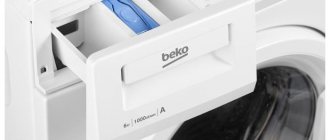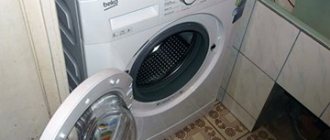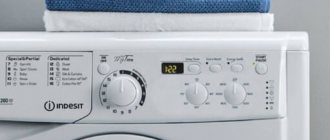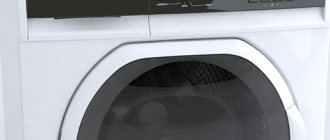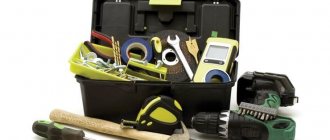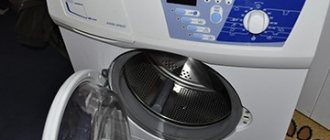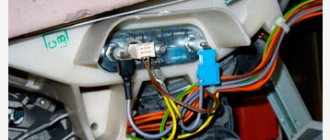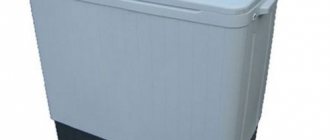Why does it hum or not make any sounds?
The dishwasher does not fill with water and is humming - this indicates a breakdown associated with the water supply path:
- the hose is clogged, bent, crushed,
- the filter is clogged,
- The supply valve does not operate due to a breakdown or blockage.
The dishwasher does not fill with water and there are no extraneous sounds - an electronic failure. "Silence" reports problems with:
- control unit,
- with water level sensor,
- aquastop or door.
List of provoking factors depending on the dishwasher model
All dishwashers work on the same principle. But everyone has different spare parts, different software, different “weak” points:
Indesit - the most common problem with water intake is related to the filling system; it needs to be cleaned more often.- For Zanussi, the weak point is the filling valve.
- Beko's water level sensor falls off more often than other models. This leads to water overflow or no water at all.
- In the second generation of dishwashers from the Bosch model range, the lack of water supply is due to an electronic control failure. The machines are very sensitive to low water pressure.
- The third generation of the Bosch model range has increased sensitivity to excess pressure. With it, the “electronic sensor” does not have time to “track” the filling of water and stops the program.
Preventing the problem from recurring
To do this, follow these simple rules:
- monitor the hoses, do not allow kinks or pinching;
- monitor the filter - carry out preventive cleaning once a month;
- if voltage surges are observed, install a stabilizer;
- if there is a frequent drop in pressure in the pipeline, install a hydraulic station;
- use only special dishwashing detergents;
- if the water is hard, carry out preventive cleaning once a month to remove scale, or constantly use anti-salt products;
- treat the door with care, closing it carefully, preventing foreign objects from entering.
Find out everything you need to know about dishwasher water in this section.
The dishwasher does not take in water: causes and repair of malfunctions
Usually a dishwasher (hereinafter also referred to as a dishwasher, PMM) works without failures, and owners quickly get used to it. But if for some reason the dishwasher does not fill with water, most users are lost and do not know what to do.
To identify malfunctions of household appliances, you need to have information about its structure and operating principle, at least in general terms. But at the same time, most breakdowns can be fixed on your own. Only in rare cases, when the damage is particularly complex, the help of a specialist is required. Let's talk in more detail about malfunctions associated with water intake.
PMM Beko DIS 5831 needs to reset errors.
Solution
Comments (6)
you need to reset the EPROM
For what? what is the problem with cleaning the eeprom manually?
Your comment +5
This machine came in for repair, the IGBT burned out on the motor control board (AEG TYP EE 218), it was replaced before me, this is clear from the owner’s answers and from the differences in the soldering.
I decided to draw a simplified diagram, so it’s clearer than the general diagram. Maybe it will be useful to someone. What do you think about this “indicator” of a heating element malfunction?
The Kandy smart touch washing machine, when you turn it on, the lock works, but still gives Error E01, and nothing happens, after a minute the lock works.
The washing machine is completely new, inverter. With a bottom module location. When you press start, the UBL is activated and the hatch is blocked. And immediately after 1-2 seconds there is a click.
The refrigerator stopped turning off. Temperature in Mor.K. -26. Everything freezes in HC. The sensor resistance is normal. Inputs from sensors come to the controller. Resist.
Hello colleagues. PMM Whirlpool WSIE 2B19 C does not heat, washes for 20 minutes, the dispenser opens but the heater is not turned on, it gives an error 2 and 4 indicator out of 5, on.
Source
Why does the dishwasher not fill with water?
In each PMM model, a certain time is programmed so that the required amount of water for washing dishes enters the tank. Typically this time period is from 10 to 15 minutes. If the water level sensor (pressostat) does not inform the control unit within the set time that the required volume of liquid has been reached, the machine stops executing the work program.
i 10 or iF appear on the displays of Electrolux and Zanussi dishwashers . When the iF0 code appears, the machine tries to continue working, the circulation pump hums, but nothing happens. By the way, in this case the electric heater (TEH) may burn out, so the device should be turned off and de-energized. German dishwashers Bosch and Siemens report defects with error codes E 3 or E8.
What to do if the dishwasher is still under warranty
For at least the first year after purchase, do not repair it yourself - by doing so, you will deprive yourself of warranty benefits. The warranty period and conditions must be clarified when purchasing household appliances.
If you use detergents that are not intended for dishwashers to wash dishes, warranty repairs may be denied.
During this period, you can work to remove blockages in the dishwasher filters. In addition, it is allowed to clean the holes in the sprinkler rocker arms from dirt and food debris if the PMM begins to wash dishes poorly.
Do not forget that many defects in work occur due to non-compliance with operating rules. The machine may not work only because there is no water in the water supply or someone has closed the inlet ball valve.
Modern authorized service centers have all the necessary tools and spare parts for warranty repairs
Therefore, you need to periodically check: the presence of electricity in the sockets, the water pressure in the water supply and the absence of blockages in the sewer. If you connect the dishwasher to the communications yourself, make sure you did everything correctly. An error may result in the PMM refusing to wash dishes.
Do not take warranty equipment for repair yourself; the store should arrange delivery
Remember: you do not need to take the PMM yourself for repairs to a service center under warranty. This must be done by the store that sold you this equipment, because it weighs more than 5 kg. It is quite possible that technicians will volunteer to repair the device at home.
Repairing damage
This section describes defects that you can fix yourself. Diagnostics and repair of the control unit will not be considered, since this is the main and most complex electronic component of the dishwasher. To restore its functionality, a high level of qualification is required. To check and replace the water level sensor, it is also better to call a specialist at home.
Cleaning filters from blockages
Many dishwasher models have two mesh filter elements. One is located at the inlet of the Aquastop solenoid valve, and the other is in the inlet fitting of the valve on the PMM body, where the inlet hose is connected. Both filters must be checked and cleaned periodically.
To remove both filters, follow a number of simple steps:
- close the inlet valve located in front of the inlet hose;
- carefully disconnect the hose from both sides so that water does not spill out of it;
- Using narrow pliers, remove the filter mesh from the Aquastop valve and from the fitting in the dishwasher body;
- rinse the filters under a strong stream of water;
- restore the structure by assembling the parts in reverse order.
Problems with the Aquastop system
If the PMM pan is flooded, an error code should appear on the display. To remove moisture from the pan, you need to disassemble the body, tilt it 30-35° (no more) and pour out the liquid. After removing the water, you need to let the machine dry, which may take 10-12 hours. If the cause of the leak has been previously eliminated, the dishwasher will continue to operate normally.
Features of typical breakdowns of Beko washing machines
As mentioned earlier, all malfunctions are accompanied by certain symptoms - from minor malfunctions to complete failure. The problem of the home handyman always lies in one thing - how to connect the existing signs of breakdown with its causes. Here you just need the knowledge and advice of specialists of a narrow profile.
Next, we will briefly summarize information about the main breakdowns.
Problematic drainage of waste water in Beko machines
If you know how to use a Beko washing machine, then you know that the waste water after washing is not clear and clean - this is the specificity of washing. To prevent dirt, threads, hair, etc. from clogging the pump, there is a special drain filter on the way to it, which mainly suffers from blockages.
Your task is to find this filter, which is usually located at the bottom of the washing machine, under a small hatch or behind a panel. How to proceed next:
- Before removing the filter, do not forget to place a basin or a rag under the machine, because residual waste water will definitely flow out of the hole.
In a number of Beko models, along with the filter, an emergency drain hose is also included - with its help it is much more convenient to drain water into any container.
- To remove the filter, simply twist it to the right.
- Next, clean the filter by hand and rinse under the tap.
- Armed with a screwdriver, you can also clean the pipe - it usually also becomes clogged with debris from waste water.
- Once you have the tools at hand, do not rush to put them away - for preventive maintenance, also clean the filter that is located on the water supply (it is located at the place where the hose is attached to the rear panel). Sand and rust from the water supply slowly collect in this filter and eventually interfere with the normal flow of water into the drum.
- After cleaning the inlet filter, do not rush to put it back in place - also check the drain pump. Often, Beko washing machines, during self-diagnosis, detect a breakdown of the pump and signal this using fault code H5. But in case of some breakdowns, the controller may not see minor violations - such as a loose impeller (can be identified by hearing a hum).
- To check the pump, start the drain mode and look into the hole in the filter plug to see how the impeller behaves. If it rotates, then everything is in order, but if not, then the pump needs to be cleaned or even replaced.
Problem with water heating in Beko machine
To fix this problem, you will also need to at least partially disassemble the Beko washing machine, but more on that below.
First, let's say that in the SM one of the most vulnerable components is the thermoelectric heater, simply the heating element. The mineral salts present in the water crystallize under the influence of hot water and settle on the heater in the form of the familiar scale - like in a kettle. The coating does not allow heat to pass through, so the heating element does not transfer it to the water and burns out.
If there is no scale, you have soft water, or you use special products, this does not mean that the heater could not burn out. The heating element has its own production resource, and maybe its time has come.
If the heating element fails, you will know about it by errors H2 and H3. To be absolutely sure what happened to it, first get to the heater. In some Beko models it is located at the rear, in others it is at the front.
So, how to disassemble a Beko washing machine, find the heating element, check and replace it, read on:
- If the heating element is located at the front, then to remove the front panel, you need to remove the hatch cuff. To remove it, act carefully - if something goes wrong, then your activity is fraught with damage to the cuff and leaks.
- You will not see the entire heating element - only its shank with two contacts and wires going to them.
- Disconnect all wires.
- Take a tester and measure the resistance. Typically, normal readings will be 25-30 ohms. If the indicators are different (for example, infinity), then the breakdown is obvious.
- Remove the heating element by unscrewing the nut from the bolt that holds it under the drum.
- Clean the installation site from debris and deposits.
- Install the new heating element in the reverse order, reconnecting all wiring.
This video shows in strict sequence how to remove, check and replace the heating element:
If the heating element turns out to be defective, then you need to check the temperature sensor (thermistor) . You will find it under the top cover. How to remove and check the sensor:
- Remove the top cover by unscrewing the screws.
- The sensor is dismantled by removing the detergent cuvette and the control panel - all of this prevents access to the element. Having reached the sensor, free it from the wires.
- The resistance measured by the tester should be 4.7 kOhm in room conditions.
- Heat the sensor in a glass of warm water - after this the readings should drop. If this does not happen, the sensor needs to be changed.
- Installing a new sensor is the same as dismantling it, just do it in reverse order.
Do-it-yourself electrical and electronics repair Beko
If you have knowledge and experience in repairing electrical appliances, then you can quickly eliminate broken contacts or their oxidation. You only need a diagram of the Beko washing machine - you will find it in the manual or on the manufacturer’s website, indicating the model of your washing machine.
As for electronics, everything is ambiguous here.
Repairing or replacing an electronic controller (control board) requires special knowledge and extensive experience.
Considering that an electronic module can cost as much as a third of your washing machine, doing it yourself is not profitable. Especially if the board needed minor repairs, which any technician can do for little money. If you “sentence” the module, you will have to buy a new one, and an innocent breakdown will end in a complex and expensive repair.
Remember that it doesn’t matter what characteristics your machine is designed for - they break in exactly the same way. If you got a Beko washing machine with a capacity of 5 kg, the faults will be the same as in a similar model with a capacity of 3 kg. To prevent your Beko washing machine from breaking down, we advise you to use the operating instructions and follow the rules prescribed there.
